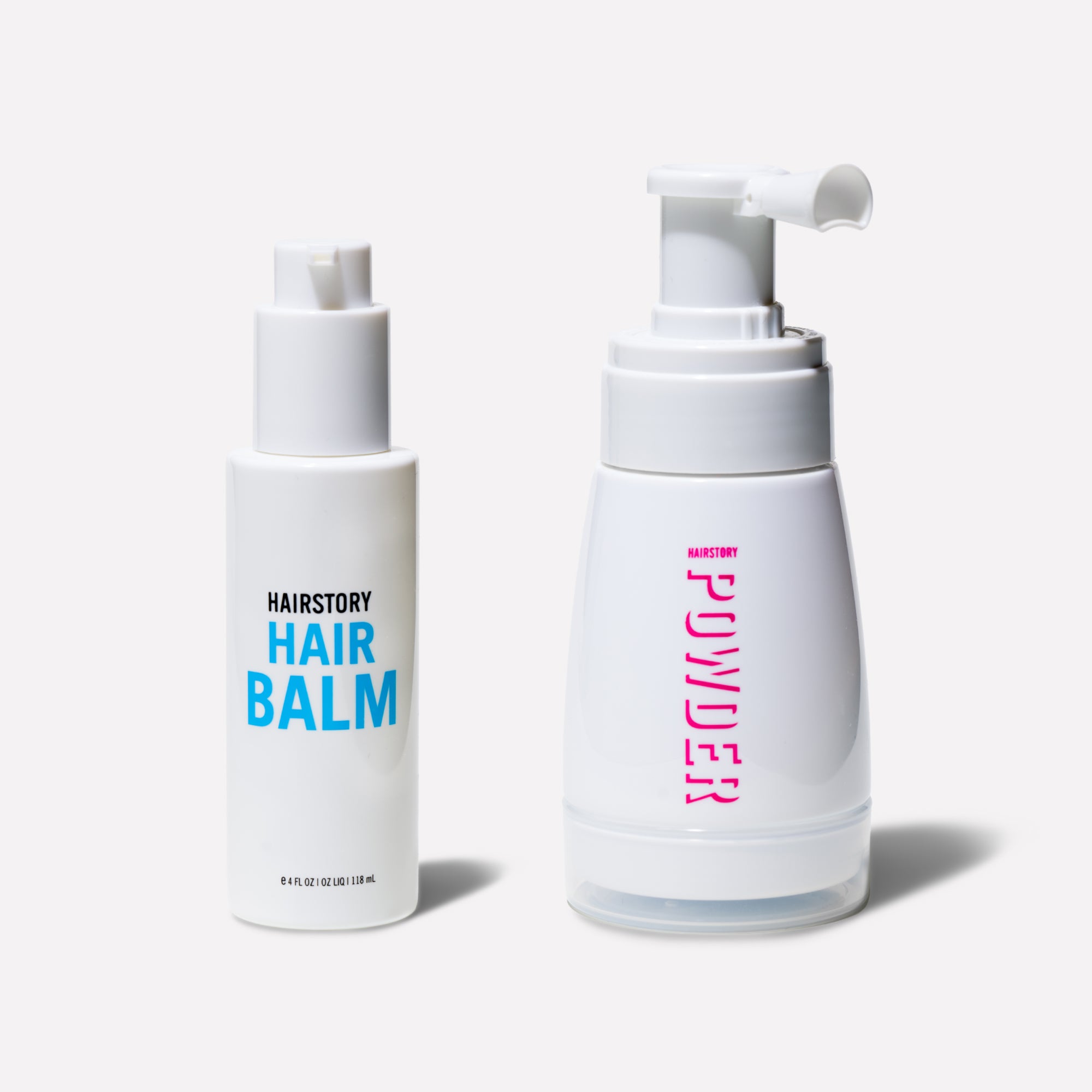On average, we grow about 100,000 hairs on our heads, according to healthline.com. We also lose between 50 and 100 hairs a day, and new hair normally grows in its place.
But when new hair doesn’t re-grow and follicles are empty of new hair bulbs, the deficit begins. Depending on the cause, the resulting loss can happen gradually or abruptly, and can be temporary or permanent. Sometimes hair care products can help with hair loss. Let’s dive into the specifics, and what is and what isn’t in your control with your hair care routine.
Hair loss and hair shedding can happen anywhere on the body where hair grows. Alopecia – the scientific name for hair loss – can be a hereditary trait, or a result of changes in hormones, a medical condition, or simply a natural part of the aging process. While anyone can lose the hair growing on their heads, it is more common in men.
HOW DO YOU KNOW YOU’RE LOSING YOUR HAIR?
We know what you’re thinking, isn’t hair loss obvious? Yes, your hairbrush and your shower drain will certainly alert you, but there are several ways that hair can thin. Excessive shedding isn't always obvious and there are several possible reasons for your hair strand loss:
- Gradual thinning on the top of head is the most common symptom, and usually increases with age. These thinning hair spots may be caused by a receding hairline or male pattern baldness.
- Circular spots or patches of baldness may appear on the scalp, beard or eyebrows, often following itchy or painful skin.
- Sudden loosening of hair may follow a severe physical or emotional shock.
- Full-body hair loss may be caused by medical conditions and their treatments, such as cancer and chemotherapy.
- Scaling patches throughout the scalp is a sign of ringworm, and may also be accompanied by hair breakage, and red, swollen, or oozing skin.
WHAT CAUSES HAIR SHEDDING?
If you’re losing your hair and can’t figure out why, these are the most common causes:
- Heredity hair loss is the most common reason hair doesn’t hang on. An estimated 80 million men and women in America develop what is called androgenic alopecia, or male pattern baldness and female pattern baldness. This is normally gradual – and predictable when you look at parents – with a receding hairline and a balding crown in men, and a broadening of the part and overall thinning in women. This type of hair loss is not, unfortunately, preventable. There are treatment options available but these do not always generate new scalp hair or create stronger natural hair.
- Hormonal changes during pregnancy, childbirth, menopause, as a result of thyroid disorders, or the discontinuation of birth control pills can also cause hair loss. This hair loss, including postpartum hair loss, is usually temporary. Once hormones return to normal levels, the growth cycle returns to normal levels and healthy hair regrows.
- Medical conditions: Alopecia areata, an auto-immune condition causes patchy hair loss, and the symptoms of ringworm may include scalp infections that can compromise healthy hair growth.
- Medications often list hair loss as a side effect of those prescribed for cancer, depression, arthritis, high blood pressure, heart disorders, and gout. A normal growth cycle usually resumes when medications are discontinued.
- Radiation therapy directed at the skull area will cause hair to shed, and it may grow back differently than before.
- Trauma or a severe physical or emotional shock can cause hair to thin several months after the traumatic event. This type of hair loss is usually temporary.
- Hairstyles that pull hair very tight – such as ponytails, buns, extensions, braids, or cornrows – can cause what is called traction alopecia by putting too much stress on the roots. Traction alopecia pulls on the hair follicle and creates hair breakage that requires new hair growth to fix.
- Extreme tension in the scalp muscles and restricted blood flow may also contribute to hair loss. A disorder that causes muscle contraction called Dystonia, and TMD (temporomandibular joint dysfunction) that causes the teeth to clench and grind while sleeping – can involve chronic muscle tension in the forehead and scalp and rob hair of nutrients.
- Allergic Reaction – Sometimes, an allergic reaction to shampoo can cause hair loss.
Japanese studies found that young men with male pattern baldness had significantly lower blood flow to the scalp than normal. Researchers at Massachusetts General Hospital have grown hair faster and thicker in mice that were given proteins to promote growth of new blood vessels.
Additional factors that can contribute to an increased risk of hair loss include:
- Significant weight loss
- Diabetes, and diseases that cause scarring such as lichen planus and some types of lupus
- A high fever
- Poor nutrition, specifically a lack of protein or iron
WHAT ARE THE TREATMENT OPTIONS FOR HAIR LOSS?
Most available treatments for hair loss are medical in nature and involve one kind of drug or another that requires lifelong dosage. And many have side effects to consider. Please note that none of the following are safe during pregnancy:
Over-the-counter medications are generally creams and gels applied directly to the scalp and contain an ingredient called minoxidil under the brand Rogaine, which was introduced several decades ago, and is also available in prescription form.
Rogaine is intended to promote hair growth and can be used to slow loss, but is not intended to stop balding or correct receding hairlines. When usage is stopped, any new hair growth will cease in weeks or months. Side effects of minoxidil include scalp irritation to the scalp, as well as increase the hair growth rate in areas near the scalp, such as the forehead and face.
The oral medication finasteride (Propecia) is also prescribed for male-pattern baldness and may promote new hair growth when taken daily. Side effects may include low sex drive and impaired sexual function, and the Mayo Clinic has established a link between finasteride and a serious type of prostate cancer.
Individuals with alopecia areata may be prescribed corticosteroids like prednisone to reduce inflammation and suppress the immune system that is attacking healthy hair. Possible side effects include glaucoma, fluid retention and swelling in the lower legs, elevated blood pressure, cataracts, and high blood sugar.
MEDICAL PROCEDURES
On the extreme end of hair loss solutions, some people resort to surgery to replace hair that no longer grows, or literally rearrange the scalp to eliminate bald areas:
Hair transplant surgery involves taking small plugs of skin from areas of the scalp that are still growing hair, and implanting them where hair has stopped growing.
People with the type of baldness that is inherited – and therefore progressive – require multiple surgeries over time.
Scalp Reduction involves removing a part of the scalp that is lacking hair and replacing it with a piece that isn’t. It can also mean folding an area of the scalp with hair over a bald patch.
Tissue expansion requires two surgeries; first, a tissue expander is placed under a section of scalp with hair next to a bald spot. Several weeks later, the expander stretches the part of the scalp that grows hair. The second surgery removes the expander and pulls the expanded area of scalp over the bald spot.
Surgical remedies can be expensive, not always successful, and they can involve risks including patchy growth, bleeding, wide scars, and infection.
HAIR SHEDDING PREVENTION
The preventable types of hair loss can be avoided with these best practices:
Be gentle. Use detangling products to avoid tugging at knots while brushing and combing, especially when your hair is wet and most elastic and breakable. A wide-toothed comb should be in your toolkit to pull conditioning products through your hair in the shower, and for the first step in after-shower care. And in general, be aware of how you might absent-mindedly touch your hair, and try not to pull, twist, or rub it.
Keep brushing. Regular brushing – with a regularly-cleaned brush – is encouraged as it helps stimulate the scalp to improve blood flow and circulation, and helps remove debris from the scalp that can smother follicles.
Go Natural. Curb your appetite for styling techniques that involve a lot of handling – and heat – such as hot rollers, curling irons, blow-dryers and permanents.
Keep it loose. Avoid hairstyles that require extreme tension, and go easy on rubber bands, clips and barrettes.
Stop smoking. Studies have demonstrated a correlation between smoking and baldness in men.
If you are a cancer patient about to undergo chemotherapy, ask your doctor about a cooling cap to reduce your risk of losing hair during treatment.
Eat well. Maintain a well-balanced diet that includes adequate amounts of iron and protein.
Relax. Stress reduction will do you a world of good, and your whole body, not just your scalp will thank you.
A special note to New Wash users: If you find that you are washing your hair less often than you did with shampoo, you may find more hair in the shower drain than you’re used to seeing. The reason is that when we naturally shed those 100 hairs a day, you don’t always notice them collecting on your clothing or floor as you do in the shower. Massaging the scalp vigorously when washing simply dislodges more hair all at once, and the hairs you see may have just been hanging in there longer.
But if you’re experiencing significantly more hair loss than usual, we encourage you to consult your doctor to see what it might be all about.
[source:https://www.healthline.com/health/hair-loss#outlook]















































